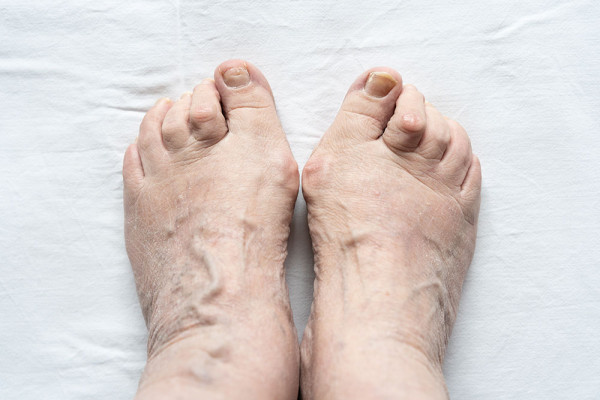Hammertoe Matiwae hama
If you have a hammertoe, it means one or more of your toes have bent abnormally. Hammertoe can develop in any of your toes, but it usually affects the middle 3 toes. Most often, it affects the second toe. It tends to run in families.
Causes of hammertoe
Hammertoe happens because the muscles and tendons of your foot do not work together properly. Over time this makes the toe bend into the hammertoe shape. If your toe stays in this position, the muscles and tendons tighten, and your toe stays bent.
Several things can lead to hammertoe. They include:
- wearing shoes that are too small or that squeeze your toes, such as high heels
- wearing flat, loose jandals that make you hold on with your toes
- an injury, for example, badly stubbing your toe
- arthritis
- nerve and muscle damage caused by diseases such as diabetes.

Photograph of a patient's feet with hammertoe
Symptoms of hammertoe
The symptoms that suggest you are developing hammertoe include:
- a bent toe
- pain and stiffness when you move your toe
- painful corns on the top of your toe, caused by rubbing against the inside of your shoe
- painful calluses on the bottom of your toe
- pain on the ball of your foot
- red, swollen toe joints.
Treating hammertoe
As long as hammertoe is not causing any pain or changing the way you walk, it does not need to be treated. Hammertoe is usually permanent, but if you follow the prevention advice, you can slow down the rate of it getting worse.
You should see a podiatrist if your toe is painful, and you have difficulty walking. The podiatrist will be able to provide advice and treatment, which may include padding the top part of your toe or taping it to change its position. They may also suggest shoe inserts (orthotics) to support your feet and keep your toes in the correct position.
Preventing hammertoe
The best way to avoid hammertoe is to make sure you wear shoes that fit you properly. Podiatrists suggest you get your feet measured properly. Then, when buying shoes:
- make sure there is a centimetre of space for your longest toe at the end of each shoe when you are standing
- shop for shoes at the end of the day — your feet naturally swell slightly during the day and tend to be bigger later in the day
- buy shoes that fit your longest foot
- always try shoes on before buying and make sure they are comfortable and have plenty of room — shoe sizes vary by brand, so it is best not to rely on size only
- make sure the tops of the shoes do not rub on your toes
- avoid shoes with pointed toes, and slip-on shoes that have no back strap, such as jandals
- buy wide shoes with good shock-absorbing soles.
You should also:
- limit the amount of time you wear high heels
- keep your toes flexible with stretches and exercises such as picking up objects with your toes.
When buying shoes for tamariki , make sure the shoes are fitted properly, especially at times the tamariki are growing quickly.
You can prevent many foot problems by following a few simple steps:
- wear comfortable shoes that fit properly, and avoid shoes that are too narrow
- wear shoes that are appropriate for your type of work and sport
- check your feet and toes regularly for any skin changes or deformities
- see a podiatrist if you have pain in a foot or toe
- stretch your foot daily to strengthen the muscles.